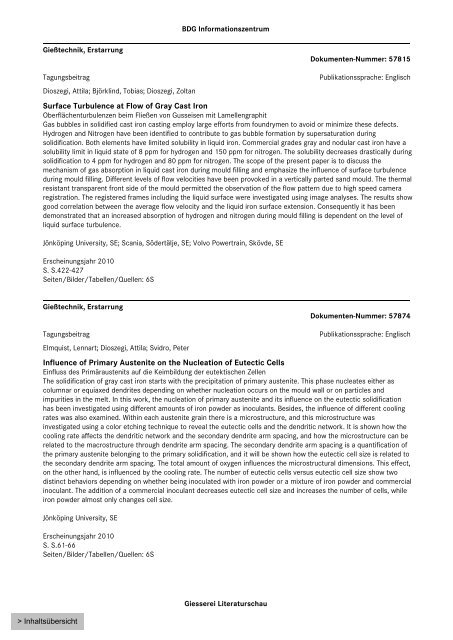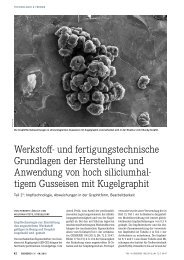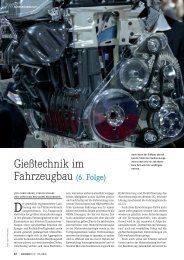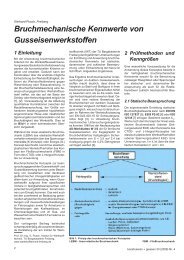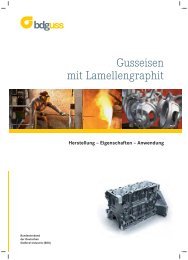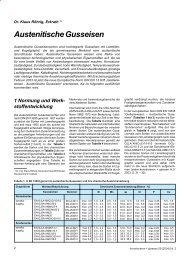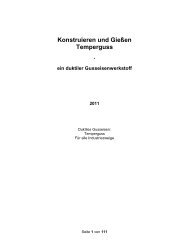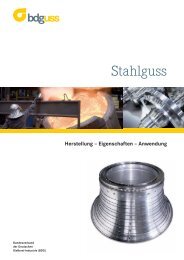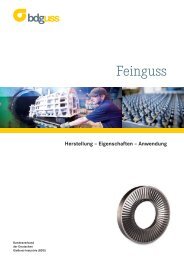Giesserei Literaturschau - Bundesverband der Deutschen Gießerei ...
Giesserei Literaturschau - Bundesverband der Deutschen Gießerei ...
Giesserei Literaturschau - Bundesverband der Deutschen Gießerei ...
Erfolgreiche ePaper selbst erstellen
Machen Sie aus Ihren PDF Publikationen ein blätterbares Flipbook mit unserer einzigartigen Google optimierten e-Paper Software.
BDG Informationszentrum<br />
Gießtechnik, Erstarrung<br />
Dokumenten-Nummer: 57815<br />
Tagungsbeitrag<br />
Dioszegi, Attila; Björklind, Tobias; Dioszegi, Zoltan<br />
Publikationssprache: Englisch<br />
Surface Turbulence at Flow of Gray Cast Iron<br />
Oberflächenturbulenzen beim Fließen von Gusseisen mit Lamellengraphit<br />
Gas bubbles in solidified cast iron casting employ large efforts from foundrymen to avoid or minimize these defects.<br />
Hydrogen and Nitrogen have been identified to contribute to gas bubble formation by supersaturation during<br />
solidification. Both elements have limited solubility in liquid iron. Commercial grades gray and nodular cast iron have a<br />
solubility limit in liquid state of 8 ppm for hydrogen and 150 ppm for nitrogen. The solubility decreases drastically during<br />
solidification to 4 ppm for hydrogen and 80 ppm for nitrogen. The scope of the present paper is to discuss the<br />
mechanism of gas absorption in liquid cast iron during mould filling and emphasize the influence of surface turbulence<br />
during mould filling. Different levels of flow velocities have been provoked in a vertically parted sand mould. The thermal<br />
resistant transparent front side of the mould permitted the observation of the flow pattern due to high speed camera<br />
registration. The registered frames including the liquid surface were investigated using image analyses. The results show<br />
good correlation between the average flow velocity and the liquid iron surface extension. Consequently it has been<br />
demonstrated that an increased absorption of hydrogen and nitrogen during mould filling is dependent on the level of<br />
liquid surface turbulence.<br />
Jönköping University, SE; Scania, Sö<strong>der</strong>tälje, SE; Volvo Powertrain, Skövde, SE<br />
Erscheinungsjahr 2010<br />
S. S.422-427<br />
Seiten/Bil<strong>der</strong>/Tabellen/Quellen: 6S<br />
Gießtechnik, Erstarrung<br />
Dokumenten-Nummer: 57874<br />
Tagungsbeitrag<br />
Elmquist, Lennart; Dioszegi, Attila; Svidro, Peter<br />
Publikationssprache: Englisch<br />
Influence of Primary Austenite on the Nucleation of Eutectic Cells<br />
Einfluss des Primäraustenits auf die Keimbildung <strong>der</strong> eutektischen Zellen<br />
The solidification of gray cast iron starts with the precipitation of primary austenite. This phase nucleates either as<br />
columnar or equiaxed dendrites depending on whether nucleation occurs on the mould wall or on particles and<br />
impurities in the melt. In this work, the nucleation of primary austenite and its influence on the eutectic solidification<br />
has been investigated using different amounts of iron pow<strong>der</strong> as inoculants. Besides, the influence of different cooling<br />
rates was also examined. Within each austenite grain there is a microstructure, and this microstructure was<br />
investigated using a color etching technique to reveal the eutectic cells and the dendritic network. It is shown how the<br />
cooling rate affects the dendritic network and the secondary dendrite arm spacing, and how the microstructure can be<br />
related to the macrostructure through dendrite arm spacing. The secondary dendrite arm spacing is a quantification of<br />
the primary austenite belonging to the primary solidification, and it will be shown how the eutectic cell size is related to<br />
the secondary dendrite arm spacing. The total amount of oxygen influences the microstructural dimensions. This effect,<br />
on the other hand, is influenced by the cooling rate. The number of eutectic cells versus eutectic cell size show two<br />
distinct behaviors depending on whether being inoculated with iron pow<strong>der</strong> or a mixture of iron pow<strong>der</strong> and commercial<br />
inoculant. The addition of a commercial inoculant decreases eutectic cell size and increases the number of cells, while<br />
iron pow<strong>der</strong> almost only changes cell size.<br />
Jönköping University, SE<br />
Erscheinungsjahr 2010<br />
S. S.61-66<br />
Seiten/Bil<strong>der</strong>/Tabellen/Quellen: 6S<br />
<strong>Giesserei</strong> <strong>Literaturschau</strong>


